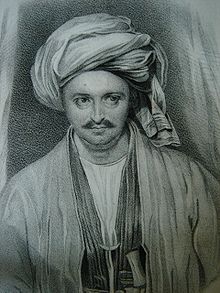Alexander Burnes
Sir Alexander Burnes (called "Bokhara Burnes"; born May 16, 1805 in Montrose (Angus) , † November 2, 1841 in Kabul ) was a British travel writer and diplomat. Through his published descriptions, he is considered to be the modern discoverer of the Buddha statues of Bamiyan in what is now Afghanistan.
Life
Alexander Burnes was born the son of a Scottish provost and was a cousin of the writer Robert Burns . At the age of 16, Burnes joined the Army of the British East India Company . In India he learned Hindustani and Persian and was employed as a translator in Surat in 1822 . In 1826 he was transferred to Kachchh , where his interest in the history and geography of the region of the North West Frontier and the countries behind it, hardly explored by the British, was aroused.
In the following years he traveled through India , Afghanistan , Persia and as far as Bukhara . He owed his nickname "Bokhara Burnes" to his trip to Bukhara. On his travels in 1832 he also passed the colossal Buddha statues of Bamiyan , which he interpreted as man and woman due to a lack of prior knowledge. His description of the statues was published in the Journal of the Asiatic Society of Bengal in November 1833. In 1834, after his return to England, Burnes published a multi-volume book about his travels, which became very popular at the time.
Burnes was sent on a political mission to Dost Mohammed , the ruler of Afghanistan, in Kabul in 1836 . There he met the Russian officer Witkewitsch. Its task was to continue the rapprochement between Afghanistan and Russia, which began in 1835. Burnes advised the British Governor General of Calcutta , Baron Auckland , to support Dost Mohammed. However, he decided to follow the opinion of William Macnaghten and reinstate the former ruler Schodscha Shah Durrani , which led to the expulsion of Burnes from Kabul and ultimately to the First Anglo-Afghan War . In 1838 Burnes was ennobled as a Knight Bachelor . After the invasion of the British Army , Burnes became a political agent in Kabul. In the course of 1841 riots broke out, fueled by tax increases by Shodja Shah Durrani and the dissolute lives of some British officers, especially Alexander Burnes. Afghan militants attacked British outposts, and in Kabul a crowd gathered in front of Burnes' house on November 2, 1841. He was discovered and murdered while trying to escape. The British garrison failed to come to his aid and the local troops fled the angry crowd. British inaction sparked a general uprising that resulted in General Elphinstone's disastrous retreat from Kabul, in which his army was completely destroyed.
Publications
- Travels into Bokhara. Being an account of a Journey from India to Cabool, Tartary and Persia. Also, narrative of a Voyage on the Indus from the Sea to Lahore (London: John Murray). 1834. 3 vols.
- Travels in India and to Bukhara. 2 volumes. Stuttgart and Tübingen, Cotta 1835–1836 ( journeys and country descriptions of the older and more recent times ) Digital copies: I , II
- Cabool. Being a Personal Narrative of a Journey to, and Residence in that City in the years 1836, 7, and 8 (London: John Murray). 1842. (posthumous)
- Kabul. Description of a trip to this city and the stay there in the years 1836, 1837 and 1838 . Translated from the English by Theodor Oelckers . TO Weigel, Leipzig 1843. MDZ Reader
Web links
- Alexander Burnes: Our man in Kabul A short biography in German.
- Works in the Internet Archive
Individual evidence
- ↑ Markus Mode: A forgotten beginning: Carl Ritter and the "Colossi of Bamiyan". For the 220th birthday of the great German geographer , Seminar for Oriental Archeology at the Martin Luther University Halle, on February 10, 1999.
- ↑ The Buddha statues of Bamiyan , complete quotation of the relevant passage from the German translation of "Reisen in India and Buchara", Stuttgart 1835.
- ^ Journal of the Asiatic Society of Bengal (Vol. 2) , 1833.
- ^ William Arthur Shaw: The Knights of England . Volume 2, Sherratt and Hughes, London 1906, p. 341
- ^ The London Gazette : 19643, 1756 , August 7, 1838.
| personal data | |
|---|---|
| SURNAME | Burnes, Alexander |
| ALTERNATIVE NAMES | Burnes, Bokhara |
| BRIEF DESCRIPTION | British explorer |
| DATE OF BIRTH | May 16, 1805 |
| PLACE OF BIRTH | Montrose (Angus) |
| DATE OF DEATH | November 2, 1841 |
| Place of death | Kabul |


